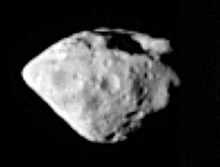2867 Šteins
 | |
| Discovery[1] | |
|---|---|
| Discovered by | Nikolai Stepanovich Chernykh |
| Discovery site | Crimean Astrophysical Observatory |
| Discovery date | November 4, 1969 |
| Designations | |
| Named after | Kārlis Šteins |
| Alternative names | 1969VC |
| Minor planet category | Main belt |
| Orbital characteristics | |
| Epoch February 4, 2008 (JD 2454500.5) | |
| Aphelion | 405.132 Gm (2.708 AU) |
| Perihelion | 301.857 Gm (2.018 AU) |
| Semi-major axis | 353.495 Gm (2.363 AU) |
| Eccentricity | 0.146 |
| Orbital period | 1326.736 d (3.63 a) |
| Average orbital speed | 19.27 km/s |
| Mean anomaly | 259.193° |
| Inclination | 9.946° |
| Longitude of ascending node | 55.530° |
| Physical characteristics | |
| Dimensions | 6.67 x 5.81 x 4.47 km[2] |
| Mean radius | 2.65 km[3] |
| Sidereal rotation period | 6.05 h |
| Albedo | 0.34 ± 0.06 |
| Temperature | ~181 K |
| Spectral type | E |
| Absolute magnitude (H) | 12.9 |
|
| |
2867 Šteins is a small main-belt asteroid that was discovered in 1969 by N. S. Chernykh.[1] It is named after Kārlis Šteins, a Latvian and Soviet astronomer.[4] Šteins was visited by the Rosetta space probe in 2008.
Physical characteristics
A study published in 2006 by astronomers at the European Southern Observatory showed that Šteins is an E-type asteroid with a diameter of approximately 4.6 km.[5] Studying the asteroid before its flyby, the Rosetta space probe showed via a lightcurve analysis that Šteins has a rotation period of about six hours, is irregular in shape, and does not have any moons.[6]
After the Rosetta flyby, the ESA described Šteins as 'a diamond in the sky', as it has a wide body that tapers into a point. The wide section is dominated by a large crater (2.1 km diameter), which surprised scientists, who were amazed the asteroid survived such an impact.[7] The photographs of Šteins taken by Rosetta allowed scientists to determine that the asteroid has dimensions of 6.67 x 5.81 x 4.47 km,[2] which equates to a mean diameter of 5.3 km.[3]
Flyby
On September 5, 2008, the Rosetta space probe flew by Šteins at a distance of 800 kilometres and a relatively slow speed of 8.6 kilometres per second. Despite the short duration of this encounter (approximately 7 minutes in total), a great number of data could be obtained by the 15 scientific instruments operating on-board the Rosetta spacecraft.[8] This was the first of two planned asteroid flybys performed by the probe, the second being to the much larger 21 Lutetia in 2010.[9] The timing of the fly-by meant that the asteroid was illuminated by the sun from the perspective of the spacecraft, making the transmitted images clear and concise.[10] The European Space Operations Centre streamed a press conference on Šteins later that day.[11]
Nomenclature
On May 11, 2012, the Working Group for Planetary System Nomenclature announced a naming system for geographical features on Šteins.[12] Inspired by the asteroid's gem-like shape, its craters are given the English-language names of precious stones, with the largest being named "Diamond". Except for the montes of Mercury and the lunar maria, the craters of Šteins are the only features in the solar system whose names are not derived from proper nouns.[13] In addition, a distinct region on the asteroid has been named "Chernykh Regio" after the discoverer.[14]
See also
References
- ↑ 1.0 1.1 "Discovery Circumstances: Numbered Minor Planets (1)-(5000)". IAU: Minor Planet Center. Archived from the original on 2 February 2009. Retrieved December 29, 2008.
- ↑ 2.0 2.1 "Rosetta's OSIRIS cameras reveal the nature of asteroid Steins". ESA Science & Technology. January 8, 2010.
- ↑ 3.0 3.1 H. U. Keller, et all - E-Type Asteroid (2867) Steins as Imaged by OSIRIS on Board Rosetta - Science 8 January 2010: Vol. 327. no. 5962, pp. 190 - 193 doi:10.1126/science.1179559
- ↑ Schmadel, Lutz (2003). Dictionary of minor planet names (fifth ed.). Germany: Springer. p. 235. ISBN 3-540-00238-3. Retrieved 2008-12-29.
- ↑ S. Fornasier, I. Belskaya, M. Fulchignoni, M. A. Barucci, C. Barbieri (2006). "First albedo determination of 2867 Steins, target of the Rosetta mission". arXiv:astro-ph/0602631.
- ↑ Michael Küppers, Uwe Keller, Rita Schulz, Gerhard Schwehm. "OSIRIS camera on Rosetta obtains ‘light curve’ of asteroid Steins".
- ↑ "Steins: A diamond in the sky". ESA Rosetta News. Retrieved 2009-05-29.
- ↑ "Encounter of a different kind: Rosetta observes asteroid at close quarters". ESA Rosetta News. Archived from the original on 10 May 2009. Retrieved 2009-05-29.
- ↑ M. A. Barucci, M. Fulchignoni and A. Rossi (2007). "Rosetta Asteroid Targets: 2867 Steins and 21 Lutetia". Space Science Reviews 128 (1-4): 67–78. Bibcode:2007SSRv..128...67B. doi:10.1007/s11214-006-9029-6.
- ↑ "Spacecraft set for asteroid fly-by". The Press Association. September 5, 2008. Retrieved 2008-09-05.
- ↑ "Rosetta Steins fly-by timeline". European Space Agency. September 4, 2008. Retrieved 2008-09-05.
- ↑ http://astrogeology.usgs.gov/HotTopics/index.php?/archives/446-First-Names-Approved-for-Asteroid-2867-Steins.html
- ↑ http://planetarynames.wr.usgs.gov/Page/Categories
- ↑ http://planetarynames.wr.usgs.gov/Page/STEINS/target
External links
| |||||
| ||||||||||||||||||||||